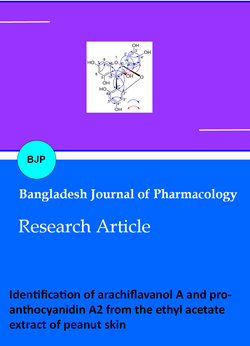Identification of arachiflavanol A and proanthocyanidin A2 from the ethyl acetate extract of peanut skin
DOI:
https://doi.org/10.3329/bjp.v20i4.83866Keywords:
Arachis hypogaea L., peanut skin, flavan-3-ol, arachiflavanol A, proanthocyanidin A2Abstract
This study detailed the isolation and structural elucidation of two flavan-3-ol derivatives from the ethyl acetate extract of peanut skin. Structural characterization was achieved through analysis of spectral data, including HR-ESI-MS, 1D and 2D NMR, [α]D measurement, and ECD spectra, identifying the compounds as arachiflavanol A and proanthocyanidin A2. Notably, this research marks the first time arachiflavanol A has been isolated from a natural source. Furthermore, both compounds demonstrated considerable antioxidant potential in the DPPH radical scavenging assay, with IC50 values of 0.07 µM/mL and 0.05 µM/mL, respectively, which were comparable to the IC50 value of the reference antioxidant ascorbic acid (0.04 µM/mL).
Downloads
65
34 Supplementary data
17
References
Appeldoorn MM, Vincken JP, Sanders M, Hollman PCH, Gruppen H. Combined normal-phase and reversed-phase liquid chromatography/ESI-MS as a tool to determine the molecular diversity of a-type procyanidins in peanut skins. J Agric Food Chem. 2009; 5714: 6007-13.
Bilia AR, Morelli I, Hamburger M, Hostetmann K. Flavans and A-type proanthocyanidins from Prunus prostrata. Phytochemistry 1996; 434: 887-92.
Bodoira R, Cecilia Cittadini M, Velez A, Rossi Y, Montenegro M, Martínez M, Maestri D. An overview on extraction, composition, bioactivity and food applications of peanut phenolics. Food Chem. 2022; 381: 132250.
Choi C, Shin J, Seo C, Hong SS, Ahn EK, Jung Y, Oh J. In vitro anti-inflammatory activity of the components of Amomum Tsaoko in murine macrophage RAW264.7 cells. AJTCAM. 2018; 15: 26-34.
Cordeiro-Massironi K, Soares-Freitas RAM, Sampaio GR, Pinaffi-Langley A, Bridi R, de Camargo AC, Torres E. In vitro digestion of peanut skin releases bioactive compounds and ıncreases cancer cell toxicity. Antioxidants (Basel). 2023; 127.
Dean LL. Extracts of peanut skins as a source of bioactive compounds: methodology and applications. Appl Sci. 10; 23.
Dean LL, Klevorn CM, Hess BJ. Minimizing the negative flavor attributes and evaluating consumer acceptance of chocolate fortified with peanut skin extracts. J Food Sci. 2016; 8111: S2824-30.
Hosseini Taheri SE, Bazargan M, Rahnama Vosough P, Sade-ghian A. A comprehensive insight into peanut: Chemical structure of compositions, oxidation process, and storage conditions. J Food Compos Anal. 2024;125:105770.
Imtiaz F, Islam M, Saeed H, Ahmed A. Phenolic compounds from Tradescantia pallida ameliorate diabetes by inhibiting enzymatic and non-enzymatic pathways. J Biomol Struct Dyn. 2023; 4121: 11872-88.
Lee SI, Yang JH, Kim DK. Antioxidant flavonoids from the twigs of Stewartia koreana. Biomol Ther. 2010;18:191-96.
Li Y, Xiang L, Qi J. Procyanidin A1 from peanut skin exerts anti-aging effects and attenuates senescence via antioxida-tive stress and autophagy ınduction. Antioxidants 2025; 14: 3.
Mingrou L, Guo S, Ho CT, Bai N. Review on chemical compo-sitions and biological activities of peanut (Arachis hypogeae L.). J Food Biochem. 2022; 467: e14119.
Monagas M, Garrido I, Lebron-Aguilar R, Gomez-Cordoves MC, Rybarczyk A, Amarowicz R, Bartolome B. Comparative flavan-3-ol profile and antioxidant capacity of roasted peanut, hazelnut, and almond skins. J Agric Food Chem. 2009; 5722: 10590-99.
Nam JW, Phansalkar RS, Lankin DC, Bisson J, McAlpine JB, Leme AA, Vidal CMP, Ramirez B, Niemitz M, Bedran-Russo A, Chen S-N, Pauli GF. Subtle chemical shifts explain the NMR fingerprints of oligomeric proanthocyanidins with high dentin biomodification potency. J Org Chem. 2015; 8015: 7495-507.
Nam JW, Phansalkar RS, Lankin DC, McAlpine JB, Leme-Kraus AA, Vidal CMP, Gan L-S, Bedran-Russo A, Chen S-N, Pauli GF. Absolute configuration of native oligomeric proanthocyanidins with dentin biomodification potency. J Org Chem. 2017; 823: 1316-29.
Sharma PK, Romanczyk LJ, Jr., Kondaveti L, Reddy B, Arumugasamy J, Lombardy R, Gou Y, Schroeter H. Total synthesis of proanthocyanidin A1, A2, and their stereo-isomers. Org Lett. 2015; 1710: 2306-09.
Ting YC, Ko HH, Wang HC, Peng CF, Chang HS, Hsieh PC, Chen IS. Biological evaluation of secondary metabolites from the roots of Myrica adenophora. Phytochemistry 2014; 103: 89-98.
Yıldırım A, Mavi A, Kara AA. Antioxidant and antimicrobial activities of Polygonum cognatum Meissn extracts. J Sci Food Agric. 2003; 831: 64-69.

Downloads
Published
How to Cite
Issue
Section
License
Copyright (c) 2025 Luyen Thi Nguyen, Uyen Thu Nguyen, Giang Hoang Do, Duong Thuy Hoang, Le Nhat Thi Bui, Minh Thu Thi Nguyen, Dat Tien Nguyen

This work is licensed under a Creative Commons Attribution 4.0 International License.
Authors who publish with this journal agree to the following terms:
- Authors retain copyright and grant the journal right of first publication with the work simultaneously licensed under a Creative Commons Attribution License that allows others to share the work with an acknowledgement of the work's authorship and initial publication in this journal.
- Authors are able to enter into separate, additional contractual arrangements for the non-exclusive distribution of the journal's published version of the work (e.g., post it to an institutional repository or publish it in a book), with an acknowledgement of its initial publication in this journal.
- Authors are permitted and encouraged to post their work online (e.g., in institutional repositories or on their website) prior to and during the submission process, as it can lead to productive exchanges, as well as earlier and greater citation of published work (See The Effect of Open Access).
